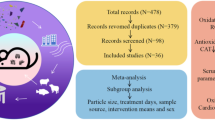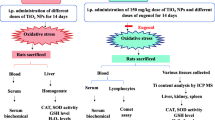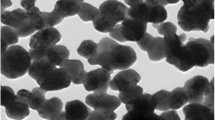Abstract
Nano-titanium dioxide is a kind of widely used nanomaterial that exhibits various adverse outcomes. However, the role of oxidative stress in this regard remains controversial. This study aimed to evaluate whether oxidative stress is one of the toxicity mechanisms induced by nano-titanium dioxide in rats and mice model. In this meta-analysis, 64 relevant publications were included through detailed database search. The pooled results showed that nano-titanium dioxide exposure could promote the expression of oxidants, such as malonaldehyde (MDA), 8-hydroxy-2-deoxyguanosine (8-OHdG), superoxide anion (O2−), and hydrogen peroxide (H2O2). Meanwhile, the levels of antioxidant-related enzymes and molecules, such as superoxide dismutase (SOD), glutathione (GSH), glutathione peroxidase (GPx), and catalase (CAT), were reduced. Subgroup analysis revealed that different intervention routes, exposure periods, exposure dosages, and sample sources could affect the oxidative stress when exposed to nano-titanium dioxide. It was worth noting that the levels of MDA, 8-OHdG, and GSH significantly increased (P < 0.05) when the particle size of nano-titanium dioxide was < 10 nm, whereas H2O2, SOD, and GPx showed the highest effect at 10–40 nm. This study indicated that nano-titanium dioxide could cause oxidative damage by affecting the levels of enzymes and molecules involved in oxidative stress in rats and mice. And these results could provide a reference for studies of the toxicity mechanism induced by nano-titanium dioxide in the future.



















Similar content being viewed by others
References
Wang Z, Zhang T, Huang F, Wang Z (2018) The reproductive and developmental toxicity of nanoparticles: a bibliometric analysis. Toxicol Ind Health 34(3):169–177. https://doi.org/10.1177/0748233717744430
Weir A, Westerhoff P, Fabricius L, Hristovski K, Goetz N (2012) Titanium dioxide nanoparticles in food and personal care products. Environ Sci Technol 46(4):2242–2250. https://doi.org/10.1021/es204168d
Pugazhendhi A, Tnji E, Karuppusamy I, Kathirvel B (2018) Inorganic nanoparticles: a potential cancer therapy for human welfare. Int J Pharm 539(1-2):1–29. https://doi.org/10.1016/j.ijpharm.2018.01.034
Chen X, Mao SS (2007) Titanium dioxide nanomaterials: synthesis, properties, modifications, and applications. Chem Rev 107(7):2891–2959. https://doi.org/10.1021/cr0500535
Kumar PSM, Ponnusamy VK, Deepthi KR (2018) Controlled synthesis of Pt nanoparticle supported TiO2 nanorods as efficient and stable electrocatalysts for the oxygen reduction reaction. J Mater Chem A 6(46):23435–23444
Shakeel M, Jabeen F, Qureshi NA, Fakhr EAM (2016) Toxic effects of titanium dioxide nanoparticles and titanium dioxide bulk salt in the liver and blood of male Sprague-Dawley rats assessed by different assays. Biol Trace Elem Res 173(2):405–426. https://doi.org/10.1007/s12011-016-0677-4
Shrivastava R, Raza S, Yadav A, Kushwaha P, Flora SJ (2014) Effects of sub-acute exposure to TiO2, ZnO and Al2O3 nanoparticles on oxidative stress and histological changes in mouse liver and brain. Drug Chem Toxicol 37(3):336–347. https://doi.org/10.3109/01480545.2013.866134
Li YS, Ootsuyama Y, Kawasaki Y, Morimoto Y, Higashi T, Kawai K (2018) Oxidative DNA damage in the rat lung induced by intratracheal instillation and inhalation of nanoparticles. J Clin Biochem Nutr 62(3):238–241. https://doi.org/10.3164/jcbn.17-70
Valberg PA, Bruch J, Mccunney RJ (2009) Are rat results from intratracheal instillation of 19 granular dusts a reliable basis for predicting cancer risk? Regul Toxicol Pharm 54(1):72–83. https://doi.org/10.1016/j.yrtph.2009.02.008
Glass DC, Mazhar M, Xiang S, Dean P, Simpson P, Priestly B, Plebanski M, Abramson M, Sim MR, Dennekamp M (2017) Immunological effects among workers who handle engineered nanoparticles. Occup Environ Med 74(12):868–876. https://doi.org/10.1136/oemed-2016-104111
Rollerova E, Tulinska J, Liskova A, Kuricova M, Kovriznych J, Mlynarcikova A, Kiss A, Scsukova S (2015) Titanium dioxide nanoparticles: some aspects of toxicity/focus on the development. Endocr Regul 49(2):97–112. https://doi.org/10.4149/endo_2015_02_97
Hongbo S, Magaye R, Castranova V, Jinshun Z (2013) Titanium dioxide nanoparticles: a review of current toxicological data. Part Fibre Toxicol 10(1):15. https://doi.org/10.1186/1743-8977-10-15
Zhang X, Li W, Yang Z (2015) Toxicology of nanosized titanium dioxide: an update. Arch Toxicol 89(12):2207–2217. https://doi.org/10.1007/s00204-015-1594-6
Chang X, Zhang Y, Tang M, Bei W (2013) Health effects of exposure to nano-TiO2: a meta-analysis of experimental studies. Nanoscale Research Letters 8(1):51–51. https://doi.org/10.1186/1556-276X-8-51
IARC (2006) Cobalt in hard metals and cobalt sulfate, gallium arsenide, indium phosphide and vanadium pentoxide. IARC Monogr Eval Carcinog Risks Hum 86:1–294
Shahin NN, Mohamed MM (2017) Nano-sized titanium dioxide toxicity in rat prostate and testis: possible ameliorative effect of morin. Toxicol Appl Pharmacol 334:129–141. https://doi.org/10.1016/j.taap.2017.08.014
Cui YL (2012) Molecular mechanisms of liver injury of mice caused by exposure to titanium dioxide nanoparticles. Dissertation, University of Suzhou. 37-38.
Sang XZ (2014) Molecular mechanisms of immune function impaired of mouse spleen following exposure to titanium dioxide nanoparticles. Dissertation, University of Suzhou.66-69.
Liu HL (2011) The biotoxicity of three kinds of typical nanomaterials. Dissertation, Chinese academy of military medical sciences.50-61.
Jia X, Wang S, Zhou L, Sun L (2017) The potential liver, brain, and embryo toxicity of titanium dioxide nanoparticles on mice. Nanoscale Res Lett 12(1):478. https://doi.org/10.1186/s11671-017-2242-2
Meena R, Kumar S, Paulraj R (2015) Titanium oxide (TiO2) nanoparticles in induction of apoptosis and inflammatory response in brain. J Nanopart Res 17(491). doi: https://doi.org/10.1007/s11051-015-2868-x
Liang G, Pu Y, Yin L, Liu R, Ye B, Su Y, Li Y (2009) Influence of different sizes of titanium dioxide nanoparticles on hepatic and renal functions in rats with correlation to oxidative stress. J Toxicol Env Heal A 72(12):740–745. https://doi.org/10.1080/15287390902841516
Abdou KH, Moselhy WA, Mohamed HM, El-Nahass ES, Khalifa AG (2019) Moringa oleifera leaves extract protects titanium dioxide nanoparticles-induced nephrotoxicity via Nrf2/HO-1 signaling and amelioration of oxidative stress. Biol Trace Elem Res 187(1):181–191. https://doi.org/10.1007/s12011-018-1366-2
Alidadi H, Khorsandi L, Shirani M (2018) Effects of quercetin on tubular cell apoptosis and kidney damage in rats induced by titanium dioxide nanoparticles. Malaysian Journal of Medical Sciences 25(2):2–81. https://doi.org/10.21315/mjms2018.25.2.8
Al-Rasheed NM, Faddah LM, Mohamed AM, Abdel BN, Al-Rasheed NM, Mohammad RA (2013) Potential impact of quercetin and idebenone against immuno-inflammatory and oxidative renal damage induced in rats by titanium dioxide nanoparticles toxicity. J Oleo Sci 62(11):961–971
Elnagar A, Ibrahim A, Soliman AM (2018) Histopathological effects of titanium dioxide nanoparticles and the possible protective role of N-acetylcysteine on the testes of male albino rats. Int J Fertil Steril 12(3):249–256. https://doi.org/10.22074/ijfs.2018.5389
Attia HF, Soliman MM, Abdel-Rahman GH, Nassan MA, Ismail SA, Farouk M, Solcan C. (2013). Hepatoprotective effect of N-Acetylcystiene on the toxic hazards of titanium dioxide nanoparticles. Am J Pharmacol Toxicol 10(6). https://doi.org/10.3844/ajptsp.2013.141.147
Canli EG, Atli G, Canli M (2017) Response of the antioxidant enzymes of the erythrocyte and alterations in the serum biomarkers in rats following oral administration of nanoparticles. Environ Toxicol Pharmacol 50:145–150. https://doi.org/10.1016/j.etap.2017.02.007
Chen AJ (2016) Central neurotoxicity through gustatory nerve pathway by instillation of ZnO and TiO2 nanoparticles. Dissertation, University of Southern Medical. 26-28.
Chen Q, Zou H, Xing M (2012) Effects of different sized titanium dioxide nanoparticles on oxidative stress in rats. Zhejiang J Pre Med 24(11):1–3
Duan YM (2011) The molecular and immune mechanisms of the mouse liver and spleen damaged by exposure to nanoparticulate TiO2. Dissertation, University of Suzhou.36-41.
El-Shenawy NS, Al-Harbi MS, Al HF (2016) Hormonal and organ-specific dysfunction induced by the interaction between titanium dioxide nanoparticles and salicylic acid in male mice. J Basic Clin Physiol Pharmacol 27(4):425–435. https://doi.org/10.1515/jbcpp-2015-0124
Zhiyi F, Yihe J, Bing L, Yinhua Z, Yixin M (2007) Study on the effect of nanosized and microsized titanium dioxide for spermatogenesis function of male rats. Pre Med Forum (02):137–140
Fadda LM, Mohamed AM, Ali HM, Hagar H, Aldossari M (2018) Prophylactic administration of carnosine and melatonin abates the incidence of renal toxicity induced by an over dose of titanium dioxide nanoparticles. J Biochem Mol Toxicol 32(3):e22040. https://doi.org/10.1002/jbt.22040
Grissa I, Ezzi L, Chakroun S, Mabrouk A, Saleh AB, Braham H, Haouas Z, Cheikh HB (2017) Rosmarinus officinalis L. ameliorates titanium dioxide nanoparticles and induced some toxic effects in rats’ blood. Environ Sci Pollut Res Int 24(13):12474–12483. https://doi.org/10.1007/s11356-017-8848-1
Gui SX (2014) Molecular mechanisms of kidney injury following exposure to titanium dioxide nanoparticles in mice. Dissertation, University of Suzhou.45-47.
Gao GD (2013) Nano-titanium dioxide exposure induced reproductive toxicity and alterations of gene expression in mice. Dissertation, University of Suzhou. 89
Hassanein KM, El-Amir YO (2017) Protective effects of thymoquinone and avenanthramides on titanium dioxide nanoparticles induced toxicity in Sprague-Dawley rats. Pathol Res Pract 213(1):13–22. https://doi.org/10.1016/j.prp.2016.08.002
Hassanein K, El-Amir YO (2018) Ameliorative effects of thymoquinone on titanium dioxide nanoparticles induced acute toxicity in rats. Int J Vet Sci Med 6(1):16–21. https://doi.org/10.1016/j.ijvsm.2018.02.002
Hu RP (2013) Molecular mechanisms of impairment of spatial recognition memory in mice following exposure to titanium dioxide nanoparticles. Dissertation, University of Suzhou.55
Jafari A, Rasmi Y, Hajaghazadeh M, Karimipour M (2018) Hepatoprotective effect of thymol against subchronic toxicity of titanium dioxide nanoparticles: biochemical and histological evidences. Environ Toxicol Pharmacol 58:29–36. https://doi.org/10.1016/j.etap.2017.12.010
Jin YL, Yang M, Su SB, Chen JY, Liu M (2014) Protective effect of propolis on redox damage induced by nano-TiO2 in rats. Chin Occup Med 41(02):147–150
Khorsandi L, Orazizadeh M, Mansori E, Fakhredini F (2015) Glycyrrhizic acid attenuated lipid peroxidation induced by titanium dioxide nanoparticles in rat liver. Bratisl Lek Listy 116(6):383–388
Khorsandi L, Orazizadeh M, Moradi-Gharibvand N, Hemadi M, Mansouri E (2017) Beneficial effects of quercetin on titanium dioxide nanoparticles induced spermatogenesis defects in mice. Environ Sci Pollut Res Int 24(6):5595–5606. https://doi.org/10.1007/s11356-016-8325-2
Li YW (2009) Studies on the acute hazards of different sized nano-titanium dioxide particles to mice. Dissertation, University of Hebei Medical. 27
Caixia Yu (2018) Effects and mechanisms of lung injury induced by nitrogen-droped nano-titanium dioxide. Dissertation, University of Guizhou Medical. 28–29
Lin L, Song GL, Zeng HM, Hongmei Z, Zhengzheng W, Longlong L, Lu S, Zhangrui X, Wei L (2017) Effect of nano titanium dioxide on the kidney female mouse. J Shihezi hihezi hihezi hihezi hihezi hihezi Univniv 35(03):344–348
Liu HT (2014) Liver injury in mice caused by nano titanium dioxide and its molecular mechanism. Dissertation, University of Suzhou. 22-24.
Liu LL, Song GL, Niu Q, Ruling M, Yusong D, Zhenzhen W, Hongmei Z, Lin L (2018) The study of the nephrotoxicity on male mice induced by Nano-TiO2. J Shihezi Univ 36(03):278–281
Liu ZM (2016) Research for the nervous system and cardiovascular system toxicity of nano-titanium dioxide. Dissertation, University of Central China normal. 22-24.
Martins AJ, Azevedo LF, de Souza RC, Carneiro M, Venancio VP, Almeida MR, Antunes LMG, Carvalho HR, Rodrigues JL, Ogunjimi AT, Adeyemi JA, Barbosa FJ (2017) Evaluation of distribution, redox parameters, and genotoxicity in Wistar rats co-exposed to silver and titanium dioxide nanoparticles. J Toxicol Environ Health A 80(19-21):1156–1165. https://doi.org/10.1080/15287394.2017.1357376
Meena R, Kajal K, P R (2015) Cytotoxic and genotoxic effects of titanium dioxide nanoparticles in testicular cells of male Wistar rat. Appl Biochem Biotechnol 175(2):825–840. https://doi.org/10.1007/s12010-014-1299-y
Morgan A, Galal MK, Ogaly HA, Ibrahim MA, Abd-Elsalam RM, Noshy P (2017) Tiron ameliorates oxidative stress and inflammation in titanium dioxide nanoparticles induced nephrotoxicity of male rats. Biomed Pharmacother 93:779–787. https://doi.org/10.1016/j.biopha.2017.07.006
Morgan A, Ibrahim MA, Galal MK, Ogaly HA, Abd-Elsalam RM (2018) Innovative perception on using tiron to modulate the hepatotoxicity induced by titanium dioxide nanoparticles in male rats. Biomed Pharmacother 103:553–561. https://doi.org/10.1016/j.biopha.2018.04.064
Morgan AM, Ibrahim MA, Noshy PA (2017) Reproductive toxicity provoked by titanium dioxide nanoparticles and the ameliorative role of tiron in adult male rats. Biochem Biophys Res Commun 486(2):595–600. https://doi.org/10.1016/j.bbrc.2017.03.098
Niu LH, Dong HT, Yang LS, Bao S, Rong Z, Yujie N (2015) Effects of different particle sizes of nano-titanium dioxide on the antioxidant capacity of mice. J Hebei Med Univ 36(02):184–187
Rizk MZ, Ali SA, Hamed MA, El-Rigal NS, Aly HF, Salah HH (2017) Toxicity of titanium dioxide nanoparticles: effect of dose and time on biochemical disturbance, oxidative stress and genotoxicity in mice. Biomed Pharmacother 90:466–472. https://doi.org/10.1016/j.biopha.2017.03.089
Sheng L, Wang X, Sang X, Ze Y, Zhao X, Liu D, Gui S, Sun Q, Cheng J, Cheng Z, Hu R, Wang L, Hong F (2013) Cardiac oxidative damage in mice following exposure to nanoparticulate titanium dioxide. J Biomed Mater Res A 101(11):3238–3246. https://doi.org/10.1002/jbm.a.34634
Shukla RK, Kumar A, Vallabani NV, Pandey AK, Dhawan A (2014) Titanium dioxide nanoparticle-induced oxidative stress triggers DNA damage and hepatic injury in mice. Nanomedicine (Lond) 9(9):1423–1434. https://doi.org/10.2217/nnm.13.100
Song G, Lin L, Liu L, Wang K, Ding Y, Niu Q, Mu L, Wang H, Shen H, Guo S (2017) Toxic effects of anatase titanium dioxide nanoparticles on spermatogenesis and testicles in male mice. Pol J Environ Stud 26(6):2739–2745. https://doi.org/10.15244/pjoes/70807
Song MF, Wang YW, Wang C, Long Z, Kailiang P, Yayin L (2015) Oxidative DNA damage in liver of mice induced by titanium dioxide nanoparticles. J Environ Occup Med 32(04):358–361
Sun QQ (2014) Long-term exposure to titanium dioxide nanoparticles induced pulmonary toxicity in mice and its molecular mechanisms. Dissertation, University of Suzhou. 28-29.
Sun Q, Tan D, Ze Y, Sang X, Liu X, Gui S, Cheng Z, Cheng J, Hu R, Gao G, Liu G, Zhu M, Zhao X, Sheng L, Wang L, Tang M, Hong F (2012) Pulmotoxicological effects caused by long-term titanium dioxide nanoparticles exposure in mice. J Hazard Mater 235:47–53. https://doi.org/10.1016/j.jhazmat.2012.05.072
Sun Q, Tan D, Zhou Q, Liu X, Cheng Z, Liu G, Zhu M, Sang X, Gui S, Cheng J, Hu R, Tang M, Hong F (2012) Oxidative damage of lung and its protective mechanism in mice caused by long-term exposure to titanium dioxide nanoparticles. J Biomed Mater Res A 100A(10):2554–2562. https://doi.org/10.1002/jbm.a.34190
Tian JZ, Guo HC, Yue XL, Yi L, Yue Z, Weiyi W, Yaning W, Rong Z, Yujie N (2014) Protection of vitamin C on the cardiac injury induced by nano-titanium dioxide in mice. Chin J Pharmacol Toxicol 28(02):227–232
Wang S (2009) Target organs selectivity induced by intratracheally instilling titanium dioxide nanoparticles in rats. Dissertation, University of Southeast. 14-15.
Wang WB, Li CL, An LH, Zang FM, Lihua Y, Hua Y, Meng E, Huinan Z, Jie L (2013) Effects of nano-TiO2 exposure on oxidative stress and hippocampus structure in rats. J Environ Health 30(12):1054–1057
Wang WB (2014) Effect of nano-titanium dioxide on the central nervous system in rat and the mechanism. Dissertation, University of Shandong.24-33.
Wang J, Chen C, Liu Y, Jiao F, Li W, Lao F, Li Y, Li B, Ge C, Zhou G, Gao Y, Zhao Y, Chai Z (2008) Potential neurological lesion after nasal instillation of TiO2 nanoparticles in the anatase and rutile crystal phases. Toxicol Lett 183(1-3):72–80. https://doi.org/10.1016/j.toxlet.2008.10.001
Wang Y, Chen Z, Ba T, Pu J, Chen T, Song Y, Gu Y, Qian Q, Xu Y, Xiang K, Wang H, Jia G (2013) Susceptibility of young and adult rats to the oral toxicity of titanium dioxide nanoparticles. Small 9(9-10SI):1742–1752. https://doi.org/10.1002/smll.201201185
Wang Y, Chen ZJ, Ba T, Ji P, Xiaoxing C, Guang J (2014) Effects of TiO2 nanoparticles on antioxidant function and element content of liver and kidney tissues in young and adult rats. J Peking Univ 46(3):395–399. https://doi.org/10.3969/j.issn.1671-167X.2014.03.011
Chang XH, Chen LS, Yang T, Meng T, Bei W (2014) Experimental study on subacute pulmonary toxicity induced by intra-tracheal instillation of nano-TiO2 in rats. J Southeast Univ (3):616–620. https://doi.org/10.3969/j.issn.1001-0505.2014.03.029
Yu X, Zhao X, Ze Y, Wang L, Liu D, Hong J, Xu B, Lin A, Zhang C, Zhao Y, Li B, Hong F (2014) Changes of serum parameters of TiO2 nanoparticle-induced atherosclerosis in mice. J Hazard Mater 280:364–371. https://doi.org/10.1016/j.jhazmat.2014.08.015
Zhang T, Tang M, Wang S, Yang Y, Mingyu L, Bing Y (2008) Effects of lung perfusion with nano-titanium dioxide particles on the oxidative damage of rat viscera. Acta Sci Natu Univ Nankaiensis (03):24–28
Zhang WJ (2009) Study on toxicological and biological activity of nano-TiO2. Dissertation, Tianjin University of Technology. 13-14.
Zhao XY (2013) Effects of different sized nano-titanium dioxide particles on the oxidative stress and DNA damage in rats after intratracheal administration. Dissertation, University of Hebei Medical.33-36.
Zhao J, Li N, Wang S, Zhao X, Wang J, Yan J, Ruan J, Wang H, Hong F (2010) The mechanism of oxidative damage in the nephrotoxicity of mice caused by nano-anatase TiO2. J Exp Nanosci 5(5):447–462. https://doi.org/10.1080/17458081003628931
Zhu Y (2015) Effect of Foxo3a on DNA damage induced by nanoparticle titanium dioxide by intratracheal administration in rat. Dissertation, University of Hebei medical.39-41.
Tripathi VK, Sivakumar AS, Dhasmana A, Hwang I (2018) Crosstalk between co-cultured 3T3-L1 and C2C12 cells after the exposure of nano-titanium dioxide. J Nanosci Nanotechnol 18(6):3870–3879. https://doi.org/10.1166/jnn.2018.15184
Ghanbary F, Seydi E, Naserzadeh P, Salimi A (2017) Toxicity of nano-titanium dioxide (TiO2-NP) on human monocytes and their mitochondria. Environ Sci Pollut R 25(7):6739–6750. https://doi.org/10.1007/s11356-017-0974-2
Hong F, Yu X, Wu N, Zhang YQ (2017) Progress of in vivo studies on the systemic toxicities induced by titanium dioxide nanoparticles. Toxicol Res (Camb) 6(2):115–133. https://doi.org/10.1039/c6tx00338a
Wu T, Tang M (2018) Review of the effects of manufactured nanoparticles on mammalian target organs. J Appl Toxicol 38(1):25–40. https://doi.org/10.1002/jat.3499
Vasantharaja D, Ramalingam V, Reddy GA (2015) Oral toxic exposure of titanium dioxide nanoparticles on serum biochemical changes in adult male Wistar rats. Int J Nanomedicine 2(1):46–53
Alarifi S, Ali D, Al-Doaiss AA, Ali BA, Ahmed M, Al-Khedhairy AA (2013) Histologic and apoptotic changes induced by titanium dioxide nanoparticles in the livers of rats. Int J Nanomedicine 8:3937–3943. https://doi.org/10.2147/IJN.S47174
Chang X, Zhang Y, Tang M, Wang B (2013) Health effects of exposure to nano-TiO2: a meta-analysis of experimental studies. Nanoscale Res Lett 8(1):51. https://doi.org/10.1186/1556-276X-8-51
Funding
This work was financially supported by the National Natural Science Foundation of China (No. 81560536) and Shihezi University Science and Technology Research and Development Project (No. RCZX201331).
Author information
Authors and Affiliations
Corresponding authors
Ethics declarations
Conflict of Interest
The authors declare that they have no conflict of interest.
Additional information
Publisher’s Note
Springer Nature remains neutral with regard to jurisdictional claims in published maps and institutional affiliations.
Chunmei Ling is the co-first author
Rights and permissions
About this article
Cite this article
An, H., Ling, C., Xu, M. et al. Oxidative Damage Induced by Nano-titanium Dioxide in Rats and Mice: a Systematic Review and Meta-analysis. Biol Trace Elem Res 194, 184–202 (2020). https://doi.org/10.1007/s12011-019-01761-z
Received:
Accepted:
Published:
Issue Date:
DOI: https://doi.org/10.1007/s12011-019-01761-z




